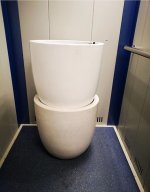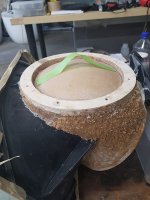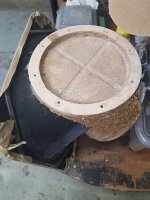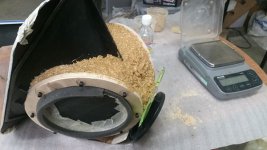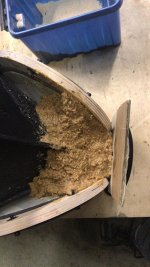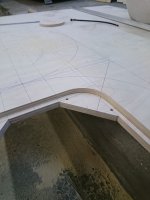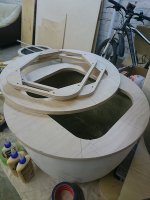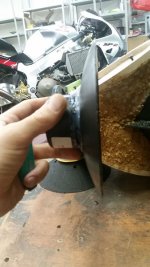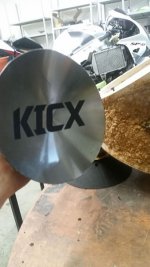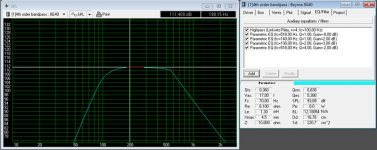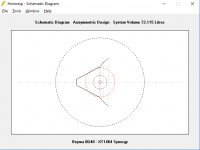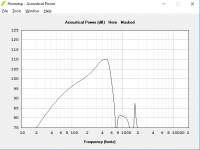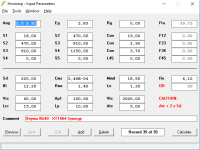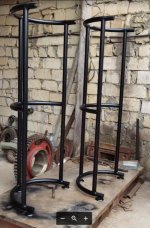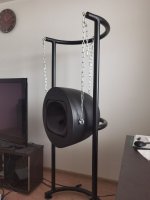Hey!
I am in the middle of building a synergy speaker based on ideas of xrk971 and Bushmeister. Yeah, i have basically stolen their ideas because i thought they are that awesome. Thank you guys!
I am using the same waveguide, only i decided to use pro drivers. The drivers i've chosen are Beyma 8G40 for midbass-lowmid and Faital HF146 for upper frequencies. I love the dynamics of pro drivers so i decided to go this route.
Now, since Beymas are capable of taking much more power than SB drivers, the size of the ports should also be larger. The question is - what would be the maximum size of the ports that is not damaging to the waveguide (causing too much diffraction)?
While the driver's is 220cm, I am currently aiming for 4 ports 50x60mm (30cm2 area) each, 2 per driver, which makes 60cm per driver. Is it too much? To little? Is it too close to the HF driver? I can't go any further from apparently because then i am touching the mid bass speaker.
I am going to cross the speaker at about 80-100Hz and will use a sub. The speakers will be used in a home theater and in a 2.1 configuration as well.
Here you can see some work in progress:
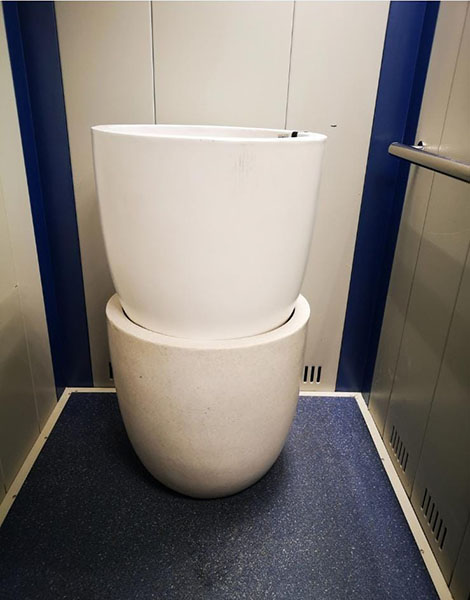
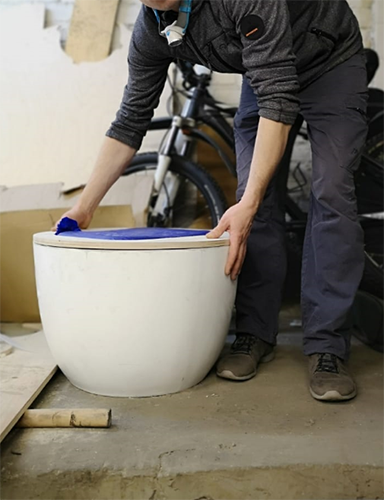
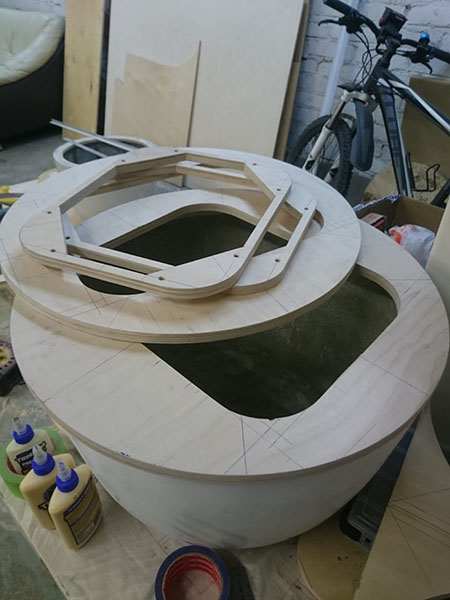
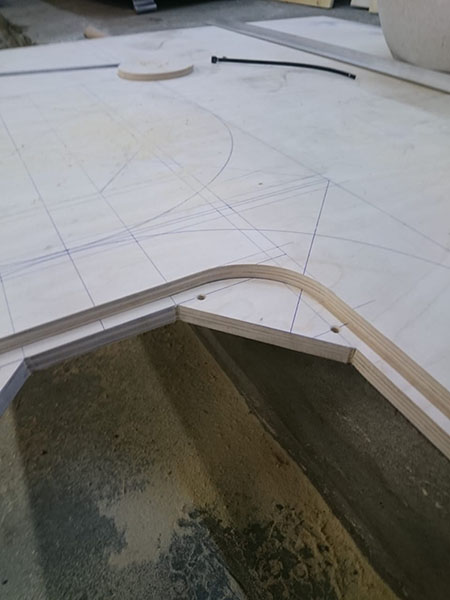

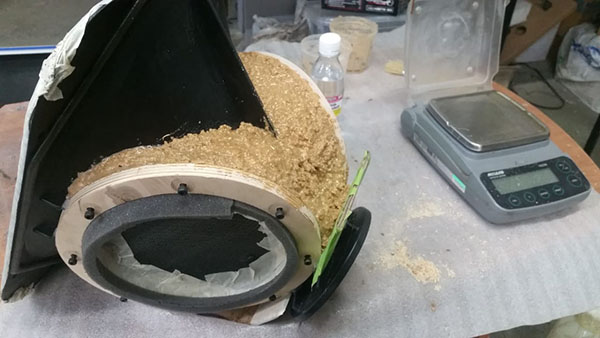
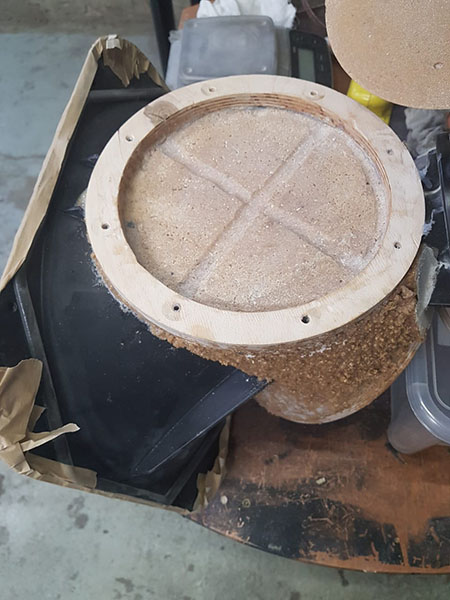
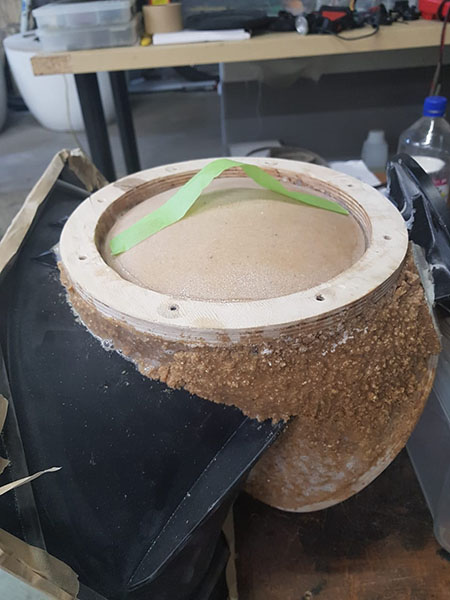
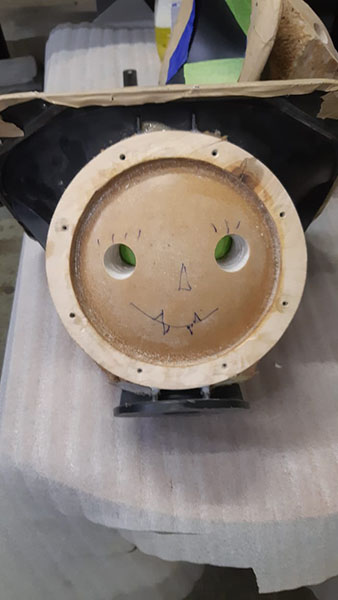
I am in the middle of building a synergy speaker based on ideas of xrk971 and Bushmeister. Yeah, i have basically stolen their ideas because i thought they are that awesome. Thank you guys!
I am using the same waveguide, only i decided to use pro drivers. The drivers i've chosen are Beyma 8G40 for midbass-lowmid and Faital HF146 for upper frequencies. I love the dynamics of pro drivers so i decided to go this route.
Now, since Beymas are capable of taking much more power than SB drivers, the size of the ports should also be larger. The question is - what would be the maximum size of the ports that is not damaging to the waveguide (causing too much diffraction)?
While the driver's is 220cm, I am currently aiming for 4 ports 50x60mm (30cm2 area) each, 2 per driver, which makes 60cm per driver. Is it too much? To little? Is it too close to the HF driver? I can't go any further from apparently because then i am touching the mid bass speaker.
I am going to cross the speaker at about 80-100Hz and will use a sub. The speakers will be used in a home theater and in a 2.1 configuration as well.
Here you can see some work in progress:
Attachments
Last edited:
An interesting design: I can't even figure out what your material is 😀
I don't know what the minimal size for your ports is, but smaller is better until port noise becomes an issue. Most important is to have port within the 1/4 wavelength distance. As you are already using the method, why not find out what port size other desgins use and steal them too 🙂
I don't know what the minimal size for your ports is, but smaller is better until port noise becomes an issue. Most important is to have port within the 1/4 wavelength distance. As you are already using the method, why not find out what port size other desgins use and steal them too 🙂
Is that vermiculite and polyester resin? Cool approach on making this!
I’ll be following this.
Actually, it is polyester resin with sawdust with particles of different size. Makes a very solid final product, hard as concrete. Which made it very hard to drill ports.
it is not me doing all the work with my hands. I have the guy who does most of the work for me and the idea of mixing resing with sawdust came from his previous experiences.
An interesting design: I can't even figure out what your material is
I don't know what the minimal size for your ports is, but smaller is better until port noise becomes an issue. Most important is to have port within the 1/4 wavelength distance.
As you are already using the method, why not find out what port size other desgins use and steal them too
Haha, yeah, that is what i started with. Bushmeister in his original design used two 50mm ports per driver, i believe, which makes an area of 40cm2. Am i pushing it too much by making the total area of 60cm2 per driver?
As for keeping the distance from the ports to the horn apex within 1/4 wavelength - how critical is it? What if one goes outside of this recommendation and then uses delay to compensate?
My rule of thumb for injection port cross sectional area is to be above 15% of the cone Sd. Make it bigger if you can to reduce losses. Too big and it disrupts your horn surface. I tried drilling 7 smaller hole rather than 1 big one. I think it helps a little. The only way to know if it’s too small is to simulate it and check for max velocity. Keep it below 15m/s.
In a WinISD simulation i am sending 100 watts of power to one driver, use 12 vents of 20mm diameter, applied some virtual PEQ to make the response look more natural before mating with a CD and with these parameters i am getting about 110dB and 15ms or port air velocity. OTOH, when you simulate just one watt io WinISD it shows 90dB of SPL. Overestimation or those Beymas are really that sensitive?
This is per one driver. One more driver will add another 6dB. I think, that should be quite enough, no? I am planning to use these speakers in a home theater setting with occasional 2.1 channel listening.


This is per one driver. One more driver will add another 6dB. I think, that should be quite enough, no? I am planning to use these speakers in a home theater setting with occasional 2.1 channel listening.
Attachments
Pro audio mid ranges are very sensitive. The Beyma is listed as
95dB but probably closer to 93dB from graphs. So getting 90dB at 2.83v is on low side. However, depending on the horn, you can get some gain there - maybe another 2-3dB? When running parallel dual it is 6dB more but twice the current.
95dB but probably closer to 93dB from graphs. So getting 90dB at 2.83v is on low side. However, depending on the horn, you can get some gain there - maybe another 2-3dB? When running parallel dual it is 6dB more but twice the current.
That extra sensitivity of those Beymas will allow me to move the upper frequency x-over position closer to what the compression driver is comfortable with by basically applying as much power as it is necessary for PEQ to shape the response before mating with the HF driver by using cuts only. I hope i explained it clearly enough 🙂
And that's the only possible way left for me to move up the frequency. I have a volume plug, but the port length is too high. When simulating a more cone-like port, the chamber volume increases and offsets any improvement gained by shortening the port length.
---
Edited the first post. I made a typo - i am using Faital HF146, not HF164.
And that's the only possible way left for me to move up the frequency. I have a volume plug, but the port length is too high. When simulating a more cone-like port, the chamber volume increases and offsets any improvement gained by shortening the port length.
---
Edited the first post. I made a typo - i am using Faital HF146, not HF164.
Last edited:
Likely two drivers is more than enough for home. You should determine how loud you like to listen as finding out as I did that 100 db peak was more than enough allowed smaller ports. It also makes a difference as to far below the recommended XO you can push the CD.
It sounds like you are doing HornResp simulations. If so, try changing the aspect ratio of your bandpass ports. Changing the aspect ratio can change the slope of the roll off towards the reflection null and might make a difference as to ports being too long with a volume plug. Often you can tune for a gradual rolloff which can then be equalized or you can get a very sharp roll off; either of which will allow a higher crossover; how much tuning you can do seems to depend on driver characteristics 15% of Sd is pretty conservative. Others use a 10% rule of thumb. I use 17 m/s peak velocity but also make sure excursion is well below Xmax.
It sounds like you are doing HornResp simulations. If so, try changing the aspect ratio of your bandpass ports. Changing the aspect ratio can change the slope of the roll off towards the reflection null and might make a difference as to ports being too long with a volume plug. Often you can tune for a gradual rolloff which can then be equalized or you can get a very sharp roll off; either of which will allow a higher crossover; how much tuning you can do seems to depend on driver characteristics 15% of Sd is pretty conservative. Others use a 10% rule of thumb. I use 17 m/s peak velocity but also make sure excursion is well below Xmax.
Hey!
The project stalled for some family and job related reasons, but was resurrected and soon going to be finished.
I ordered stands for these speakers which i "designed" in SketchUp:


Stands came out too tall for my needs 🙂 But gonna keep them anyway. Too much work to remake them.
Next thing, i will be painting speakers with a black paint. I also needed an x-over with PEQ and decided to go with Mosconi 4to6 as a DSP, which i found cheap at a local classifieds ads site. This is a car DSP, but nothing is stopping me to using it from home.
Now i need a solution for amplification. I am currently choosing an old used receiver also at classifieds. Do not know which to pick. Most of them are designed to be used with 6Ohm loads and higher. My Beymas are 8Ohm. Since i am using two per speaker, they should be connected either in series or parallel, so that gives either 4 Ohm or 16 Ohm. Am i going to lack SPL with series connection and using a receiver which is rated 100 Watts per 8 Ohm, for example?
Another problem that i am foreseeing (which i should foresaw earlier in the design stage) cancellation notch. The center of injection ports are at 17cms from the throat. I think, Faital HF146 has another 1-1,5cm, which makes throat 18-19cm deep. Here is how the model looks in HornResp:



Am i going to have problems crossing midbass at around 450Hz with Faital HF146?
Here is how their response looks as per datasheet:

The project stalled for some family and job related reasons, but was resurrected and soon going to be finished.
I ordered stands for these speakers which i "designed" in SketchUp:
Stands came out too tall for my needs 🙂 But gonna keep them anyway. Too much work to remake them.
Next thing, i will be painting speakers with a black paint. I also needed an x-over with PEQ and decided to go with Mosconi 4to6 as a DSP, which i found cheap at a local classifieds ads site. This is a car DSP, but nothing is stopping me to using it from home.
Now i need a solution for amplification. I am currently choosing an old used receiver also at classifieds. Do not know which to pick. Most of them are designed to be used with 6Ohm loads and higher. My Beymas are 8Ohm. Since i am using two per speaker, they should be connected either in series or parallel, so that gives either 4 Ohm or 16 Ohm. Am i going to lack SPL with series connection and using a receiver which is rated 100 Watts per 8 Ohm, for example?
Another problem that i am foreseeing (which i should foresaw earlier in the design stage) cancellation notch. The center of injection ports are at 17cms from the throat. I think, Faital HF146 has another 1-1,5cm, which makes throat 18-19cm deep. Here is how the model looks in HornResp:
Am i going to have problems crossing midbass at around 450Hz with Faital HF146?
Here is how their response looks as per datasheet:

Attachments
Last edited:
Should probably work, eh?

Tried manipulating frequency response of the CD with what i get in HornResp model while using the same scale.
MidBass response is EQed a bit - peak at about 450Hz was removed, HP filter 4th order applied at 80Hz and 1st order LP applied at 640Hz.

Tried manipulating frequency response of the CD with what i get in HornResp model while using the same scale.
MidBass response is EQed a bit - peak at about 450Hz was removed, HP filter 4th order applied at 80Hz and 1st order LP applied at 640Hz.
In the process of painting them black. Need one more layer. As seen on the photo, U-Pol's i used Raptor. Color balance is off on the photos:




Here is a comparison of 2 Beymas firing into XT1464 Horn with a vented box tuned to 60Hz:

If i am going to use a subwoofer and crossing at about 80Hz, maybe using a vented alignment is a good idea?

If i am going to use a subwoofer and crossing at about 80Hz, maybe using a vented alignment is a good idea?
A simulation of 4th and 6th order bandpasses in WinISD with parameters corresponding to my application:

A vent tuned to 60Hz strongly increases sensitivity.
I am using a slot port in the simulation, 3x20cm. The front wall of the speaker is made of two 15mm layers of plywood, so i can simply cut a rectangular whole.

A vent tuned to 60Hz strongly increases sensitivity.
I am using a slot port in the simulation, 3x20cm. The front wall of the speaker is made of two 15mm layers of plywood, so i can simply cut a rectangular whole.
- Home
- Loudspeakers
- Multi-Way
- Another attempt at (stealing) making a Synergy speaker.
